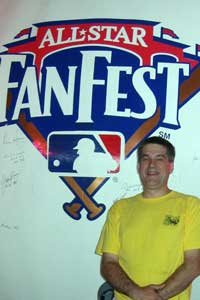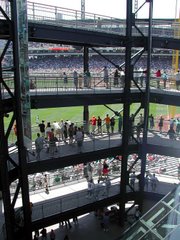I received an e-mail from Joe Agnello, who works for the Pennsylvania Turnpike Commission and shares my interests in subjects like baseball and good rock music of the '60s and '70s.
Here's part of what Joe wrote:
"A couple years ago I went hunting for pitchers who threw at least 300 innings in a given season and, for the same season, recorded an ERA under 2.00. What would a pitcher who could do that be worth today? In fact, you can’t find any two pitchers (probably not even three) on any team whose combined stats would measure up to that. Near as I could tell, it’s been done seven times since 1950. Incredibly, Sandy Koufax did it twice and almost did it a third time. Former Bucco Wilbur Wood did it with the Chisox of the early 1970s. Wood TWICE won 20 games and lost 20 games in the same season. You talk about an innings eater!
"By the way, among the pre-1950 accomplishers of these freak stats was one George Herman Ruth with the Bosox. Bring that up the next time someone proclaims Barry Bonds as the greatest player of all time."
Interesting stuff, Joe. Here is a complete list of the pitchers with the criteria he cites since 1950:
Sandy Koufax, 1963, 311 innings, 1.88 ERA
Sandy Koufax, 1966, 323 innings, 1.73 ERA
Bob Gibson, 1968, 305 innings, 1.12 ERA
Denny McLain, 1968, 336 innings, 1.96 ERA
Wilbur Wood, 1971, 334 innings, 1.91 ERA
Vida Blue, 1971, 312 innings, 1.82 ERA
Steve Carlton, 1972, 346 innings, 1.97 ERA
Gaylord Perry, 1972 , 343 innings, 1.92 ERA
That actually adds up to eight pitchers, and as Joe says, Koufax just barely missed a third time, posting an ERA of 2.04 in 336 innings in 1965.
A couple of notes:
• Some revisionists have tended to downgrade Koufax's accomplishments, citing his home park, Dodgers Stadium, as having highly unfavorable conditions for hitters. Plus, before the height of the pitcher's mound was standardized, Dodger pitchers allegedly were a couple of feet above the batters. Whatever the case, no other Dodger starter posted anything comparing to Koufax's numbers, and that staff included two other Hall of Famers, the Dons Drysdale and Sutton.
• Gibson and McLain, of course, were the brightest stars in the Year of the Pitcher, when offensive statistics dwindled to the point where the Yankees compiled a .214 team batting average. The baseball powers that be promptly put rules in place to give the hitters a better shot. It worked, at least for a few years.
• I remember watching Vida Blue pitch to Willie Mays, the first batter in the '71 All-Star Game. Willie was 40 by then, and the consensus is that he never saw any of the pitches before walking back to the bench after striking out. He heard them, maybe. Blue was 17-2 heading into the game and was baseball's biggest story, similar to Fernando Valenzuela 10 years later. But he held out prior to 1972 and slumped to 6-10. Although he had a few decent years for Oakland and later across the bay in San Francisco, he never again approached the status he held in mid-'71.
• Baseball history stats guru Bill James cites Wood's 1971 performance as being even better than Blue's. Wood, a knuckleballer, had led the American League in appearances as a reliever in 1970, but his White Sox posted the worst record in the majors by a long shot, so they figured they had nothing to lose by converting Wood to a starter. In 1972, Wood hurled 377 innings, and in 1973, he started both games of a doubleheader.
• There isn't enough hyperbole for Carlton's 1972 season. We'll take a closer look at that later.
• Perry is remembered today mainly because he admitted to -- bragged is more like it -- throwing the spitball, which has more or less been outlawed since 1920. He won 24 games in 1972 for a Cleveland team that won only 72 games and scored just 472 runs. With a little bit of offensive support, Gaylord might have been the last 30-game winner, instead of McLain.
• Look up Babe Ruth's pitching numbers any time you want to debate who was the greatest player of all time.
Trivia question 7: The American League's offensive statistics in 1972 were almost as dire as in '68, the Year of the Pitcher. What rule change was instituted in '73 to beef up batters' numbers?
Subscribe to:
Post Comments (Atom)









No comments:
Post a Comment